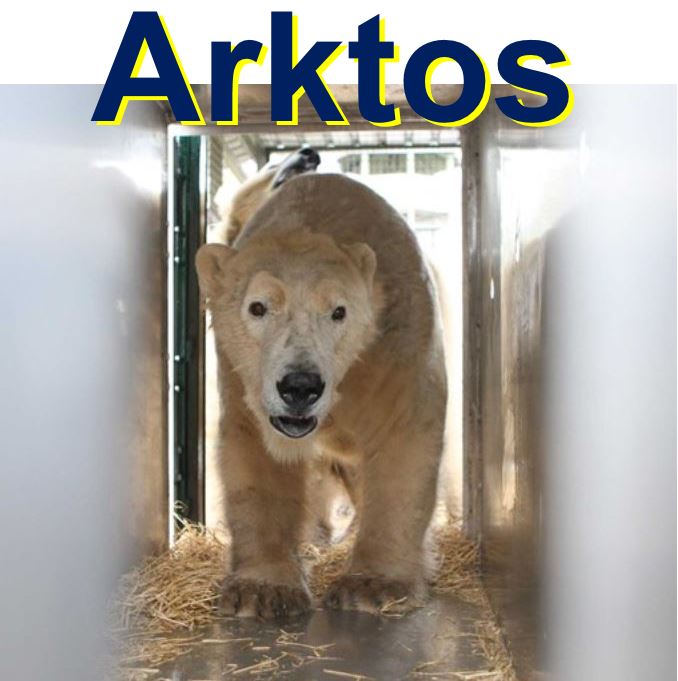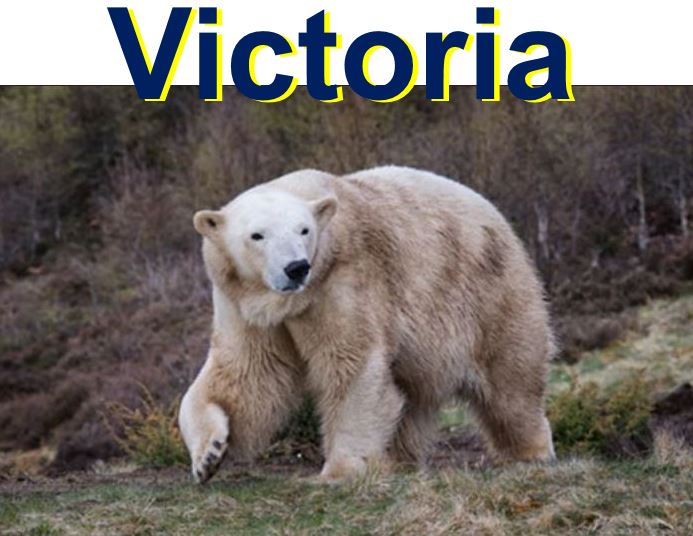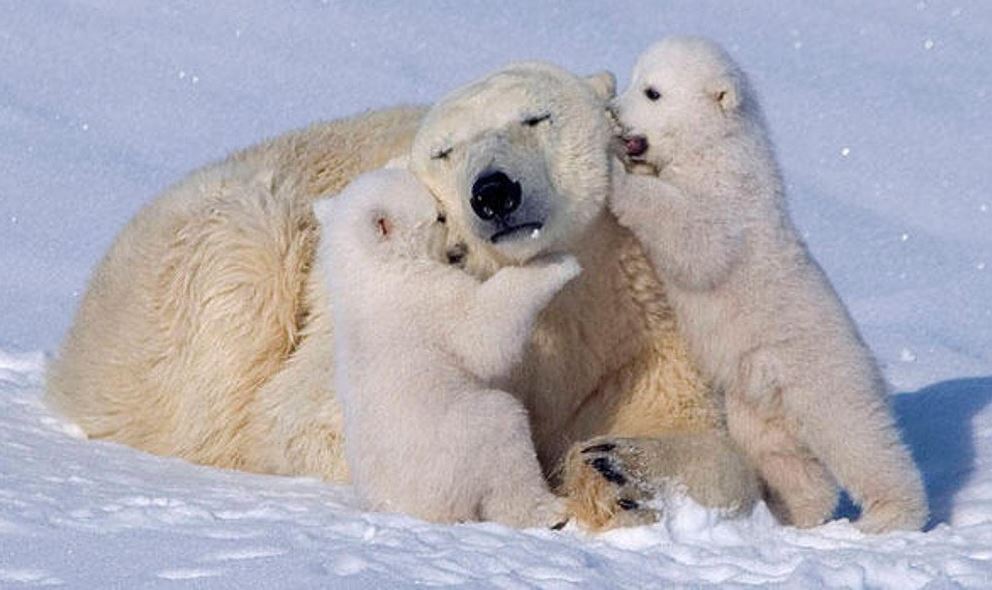Polar bears are to be bred at a wildlife park in Scotland. A male polar bear called Arktos will be moved one mile to his (hopefully) future mate Victoria. This is the first time polar bear breeding has been attempted in Scotland. ‘Arktos’, which refers to ‘bears’ in Greek (ἄρκτος), was also a centaur in Greek mythology who fought against the Lapith spearmen.
The Royal Zoological Society of Scotland (RZSS) says this is the latest and most exciting step in its effort to contribute to the European breeding programme for polar bears, which are currently listed as Vulnerable on the IUCN Red List of endangered animal species.
Protecting the future of polar bears is no simple task, as it is the reduction of sea-ice caused by global warming that is the primary threat to the species, i.e. their natural habitat is slowly vanishing.
 Arktos in the transportation box. He needs to get used to it before the keepers can transport him. (Image: rzss.org.uk)
Arktos in the transportation box. He needs to get used to it before the keepers can transport him. (Image: rzss.org.uk)
Polar bear future uncertain
According to recent research, the polar bear global population is likely to decline by more than 30% in just three generations if sea-ice loss continues according to forecasts.
The RZSS feels that it has a duty to help with the establishment of a healthy population of ex-situ animals. Ex-situ conservation means that either actions are taking place to remove a species form its natural setting, or that species is being protected in captivity (away from its natural habitat).
The Society emphasizes that this is not a substitute for conserving polar bears in the wild, but rather to ensure that the species has a broad range of survival options in the future. If the wild population disappears one day, the species will still exist in Scotland and other wildlife centres around the world.
Getting Arktos ready to be transported
On Friday, 19th February, a large 3 x 1.5 metre transportation crate was placed into position in the male polar bear enclosure. The aim is for eight-year-old Arktos to get used to it. It is not possible to simply push him into the crate and move him just like that – the breeding programme would be severely undermined.
 Victoria, the female polar bear. Everybody is hoping that she and Arktos will get on, mate and have cubs. (Image: rzss.org.uk)
Victoria, the female polar bear. Everybody is hoping that she and Arktos will get on, mate and have cubs. (Image: rzss.org.uk)
A gradual process of getting Arktos to view the crate as a nice place will be used by his keepers (positive reinforcement training). His favourite treats will be place inside it regularly.
When he is ready, Arktos will be transported one mile away to Victoria’s enclosure. Hopefully, Victoria and Arktos will eventually mate and have cubs.
If all goes according to plan, his courtship with Victoria will begin around the middle of March. Victoria’s enclosure was very carefully planned, with breeding in mind.
A gradual courtship process
RZSS believes Victoria’s enclosure is unique, because it offers maximum animal management flexibility. It has a smaller holding enclosure where Arktos will live adjacent to but separated from Victoria, until their behaviour suggests to the keepers that they are ready for a full introduction.
RZSS has become world-famous as a leading authority on polar bears, with its enclosure design and husbandry approach, which have been adopted by several zoological organizations across the globe.
The polar bears at the RZSS Highland Wildlife Park enjoy more space than any other zoological institution in the world offers. The area spans more than 10 acres (four hectares), while the enclosures feature trees, ponds, natural slopes and soft grassy areas.
 The total gestation period for a polar bear is about eight months. Females need to gain at least 200 kg (441 lb) for a successful pregnancy. Most litters consists of two cubs, followed by litters of one. Litters of three are less common than singles or twins, while litters of four are extremely rare. (Image: onegreenplanet.org)
The total gestation period for a polar bear is about eight months. Females need to gain at least 200 kg (441 lb) for a successful pregnancy. Most litters consists of two cubs, followed by litters of one. Litters of three are less common than singles or twins, while litters of four are extremely rare. (Image: onegreenplanet.org)
Captive polar bears live better today than before
Polar bear husbandry has improved considerably over the past couple of decades. The RZSS says it is now unrecognizable compared to what existed ten years ago, when several negative stories about polar bears in captivity hit the headlines.
Following comprehensive research by zoologists in Europe and North America, the international zoo community has an ‘incredibly thorough understanding” of how to care for polar bear cubs, improve their survival rates, and husbandry requirements.
Head of Living Collections at RZSS Highland Wildlife Park, Douglas Richardson, said:
“When we first take Arktos to Victoria, he will live in a separate enclosure adjacent to hers. The two bears will be able to communicate and interact through a secure large fence to start with. We fully expect to see them showing an interest in each other right away.”
“As with any introduction of large predators, the process must be approached slowly and carefully, paying close attention to positive behavioural indicators, like vocalisations and body posture. Whether we wait until Victoria comes into full breeding condition before mixing them together will depend on how they react to each other in the build-up to that key point.”
Polar bear conservation is a complicated and intricate process. As a conservation body, the RZSS, with its vast bear husbandry experience, says it cannot shy away from the task at hand.
If we are serious about keeping all the conservation options open for the future of polar bears, we need to accept the idea that a healthy captive population may help secure the species’ survival.
Captive polar bears might save the species
Mr. Richardson added:
“The birth and rearing of polar bears cubs will be of real value to the overarching breeding programme. As well as helping to highlight the plight of polar bears in the wild, any cubs born in the foreseeable future will remain within the vital safety net of the captive breeding programme.”
“The shrinking polar ice-cap and shortening polar ice season has pitched the species to the forefront of conservation concerns. In an ideal world, conservation would happen first and foremost in the wild, but unfortunately this is not the scenario we are dealing with.”
A combined approach, with polar bears in their natural habitat and also in captivity, existing simultaneously and in a joined-up manner, is the next best thing, Mr. Richardson believes.
He says that zoos have a duty of care to help polar bears survive. Their combined efforts are helping to preserve as varied a mix of genes as possible. These animals could be returned to the wild one day if conditions were right.
If Victoria has cubs, they will probably never go back to the wild, but further down the line her descendants may well play a vital role in restoring or increasing polar bear populations in the Arctic.
RZSS Video – Polar bears enjoying snow in Scotland
This video shows two male polar bears – Arktos and Walker – enjoying the snow at Highland Wildlife Park in Scotland.

